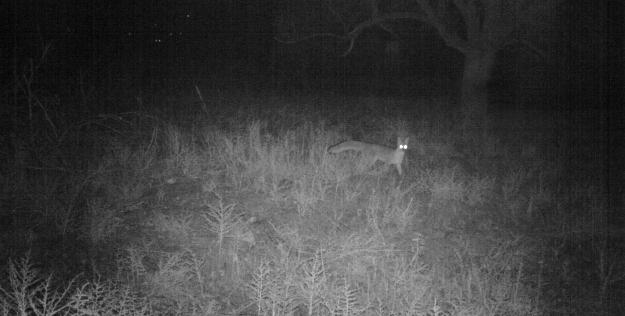Wild Pantex – Spotlight on Wildlife
Article by Jim Ray, Pantex Wildlife Biologist/Scientist
Our pickup made its way slowly down the dusty two track pasture road. We were two miles into a 24-mile spotlight survey that we had begun once it had gotten good and dark. Our crew consisted of a spotlighter for each side of the vehicle, a Security Police Officer to provide key support and, on this night, a co-worker had come along to help us out as a data recorder. And trust me, our night had been well coordinated – assistance by Security, and notification to the Pantex Operations Center, Carson County Sherriff’s Office, Texas Parks and Wildlife Department, and Texas Tech Research Farm.
As we crept along, one million-power spotlights shown out each side of the vehicle. Its holder would watch for eye-shine, or even the outline of the animal itself if close enough to the vehicle. We stop and glass (binoculars) an animal when we need to, but otherwise we record what we have seen at the end of every mile.
We had already observed two deer and a few cottontails when Monty Schoenhals asked me to stop and identify a set of eyes that would occasionally light-up as it made eye contact with us. Through my binoculars I could tell it was a deer, but I needed it to stand-up in order to have a chance of identifying the species. A quick blow on a predator call and it did just that. An eventual glimpse of its light-colored rump and rope-like tail positively identified it as a mule deer and off we went continuing along the survey route.
Spotlight surveys are an important element of our natural resources surveillance program. We spend much time and effort trying to document and monitor our natural resources, and we utilize that information for protecting them, and making land management decisions. I initiated the spotlight surveys back in 2000, my second year at Pantex. Initially, they were aimed at trying to detect swift fox, then, a subject of much debate as to its presence or absence. I had participated in many a deer survey over the years and had also assisted with those for swift fox. Although, not a good technique to estimate numbers of swift fox in an area, you can sure detect their presence if there is a population. Although there is no hint of a swift fox at Pantex, the surveys have been continued due to the opportunity to document and monitor the other nocturnal animals that we come across.
A typical spotlight survey will take us from two to three hours to conduct depending on how many stops that we have to make to glass and identify eyes that are a considerable distance from the vehicle. Animals that we have recorded over the years on these surveys include badgers, black-tailed jackrabbits, bobcats, cottontails, coyotes, gray fox, feral cats, mule deer, raccoons, striped skunks, and white-tailed deer. In some years, it may be the only means of documenting a badger, a gray fox or, less so, a white-tailed deer.
We use the spotlight data every year to supplement other data gathered by a variety of survey methods. For the most part, I just use it for presence/absence-type data and this is included in annual reports and all-time species lists.
Whether in Palo Duro Canyon, the Canadian River bottom, or on the flat plains of Pantex, it sure is a different world out there at night in the lit-up beam of a spotlight. It is another view of our Wild Pantex, one that most will not get to see, and one that we look forward to every year.

